Bengal fox
The Bengal fox (Vulpes bengalensis), also known as the Indian fox, is a fox endemic to the Indian subcontinent and is found from the Himalayan foothills and Terai of Nepal through southern India[2] and from southern and eastern Pakistan to eastern India and southeastern Bangladesh.[3][4][5]
| Bengal fox | |
|---|---|
_at_Desert_NP_(cropped).jpg) | |
| Bengal fox at Desert National Park, Jaisalmer, India | |
| Scientific classification | |
| Kingdom: | Animalia |
| Phylum: | Chordata |
| Class: | Mammalia |
| Order: | Carnivora |
| Family: | Canidae |
| Genus: | Vulpes |
| Species: | V. bengalensis |
| Binomial name | |
| Vulpes bengalensis (Shaw, 1800) | |
 | |
| Range map | |
| Synonyms | |
|
Canis kokree | |
Appearance
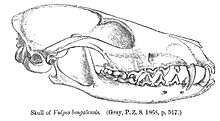
Vulpes bengalensis is a relatively small fox with an elongated muzzle, long, pointed ears, and a bushy tail about 50 to 60% of the length of the head and body. Its dorsal pelage is very variable, but mostly grayish and paler ventrally; its legs tend to be brownish or rufous. It is more daintily built than Vulpes vulpes.[6] The tail is bushy with a prominent black tip which distinguishes it from V. vulpes. Back of ears are dark brown with black margin. Its rhinarium is naked and the lips are black, with small black hair patches on upper part of nuzzle (shaft) in front of eyes. The ears have the same colour as the nape or maybe darker, but not having a dark patch as in V. vulpes. Extensive variation in coat colour exists across populations and seasonally within populations, but generally varies from grey to pale brown. The head and body length is 18 in (46 cm), with a 10 in (25 cm) long tail. Typical weight is 5 to 9 pounds (2.3 to 4.1 kg).[3]
The genus Vulpes can be separated from Canis and Cuon in the Indian region by the flat forehead between the postorbital processes and not inflated by air cells. The processes themselves are slightly concave with a raised anterior edge (convexly round in other canids). The canine teeth are longer.[7]
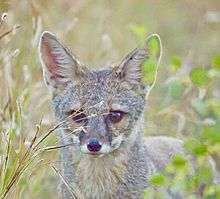
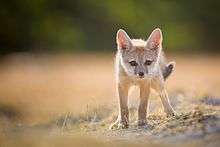
Distribution and habitat
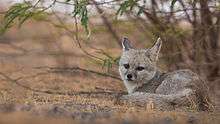

The Bengal fox is distributed throughout much of the Indian subcontinent with the exception of the wet forests and the extreme arid zone. Its range is bounded by the Himalayas and the Indus River valley. Its preferred habitat is short open grassland, scrub or thorn forest. It appears to avoid steep terrain and tall grassland.[3] It was considered to be a habitat generalist, but it shows a strong preference for semiarid, short grassland habitats at multiple scales.[8]
Behaviour and ecology
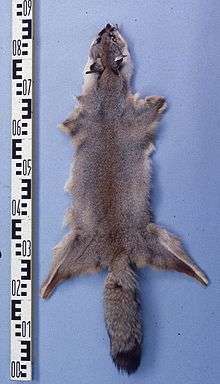
Bengal foxes are mainly crepuscular in their habits. During the heat of the day, they hide under vegetation or in subterranean dens that they dig. The dens are large and complex with multiple chambers and escape routes. They are sometimes seen basking at a vantage point around sunrise or sunset.[9] In captivity, the lifespan is about 6 to 8 years.[3]
Diet
The Bengal fox feeds on rodents, reptiles, crabs, termites, insects, small birds, and fruits.[10] Scats of young pups appeared to show that they fed mainly on rodents[11] but are opportunistic feeders.[9]

Communication
Foxes make a wide range of vocalizations. A chattering cry is the most common call. They also growl, whine, whimper, and bark. The Bengal fox does not appear to have latrine behaviour, a feature seen in some social canids, in which all members defecate at specific spots.[9] They can be heard howling in the night in groups.
Reproduction
The Bengal fox forms pair bonds that may last a lifetime, but extra-pair copulations are known to occur. Throughout most of its range, the mating season starts in autumn (usually October–November) and after a gestation period around 50–60 days, two to four pups are born in a den. Both parents participate in pup-rearing. The pups are fully weaned about 3–4 months after emerging from the den. Pup mortality is high during the first few months.[12] Pups may sometimes be nursed by multiple females.[9] During the day, they tend to rest under shrubs and bushes, except in summer when they rest in dens.
Threats
Lack of habitat protection is perhaps the greatest threat to the Indian fox. For example, in southern India, less than 2% of potential Indian fox habitat is covered under the existing protected area network of the states of Karnataka and Andhra Pradesh .[13] Hunting for its skin and flesh, as well as conversion of its grassland habitat to agriculture, industry, and increasingly bio-fuel plantations, have affected its population density. In addition, its body parts are used in traditional medicine, and in some areas it is eaten. They are hunted by the narikuruva tribes of southern India.[9] In Karnataka, they are captured in rituals conducted during Sankranthi.[3] Another major threat is disease such as canine distemper virus and rabies, which spills over from the large unvaccinated populations of free-ranging dogs found throughout their range.[14]
References
- Jhala, Y.V. (2016). "Vulpes bengalensis". IUCN Red List of Threatened Species. 2016: e.T23049A81069636.
- Vanak, A.T. (2005). "Distribution and status of the Indian fox Vulpes bengalensis in southern India" (PDF). Canid News. 8 (1).
- Gompper, ME & A.T. Vanak (2006). "Vulpes bengalensis" (PDF). Mammalian Species. 795: 1–5. doi:10.1644/795.1.
- Wozencraft, W.C. (2005). "Order Carnivora". In Wilson, D.E.; Reeder, D.M (eds.). Mammal Species of the World: A Taxonomic and Geographic Reference (3rd ed.). Johns Hopkins University Press. pp. 532–628. ISBN 978-0-8018-8221-0. OCLC 62265494.
- Mivart, St George (1890). "Dogs, jackals, wolves and foxes: A monograph of the Canidae". R H Porter, London: 126–131. Cite journal requires
|journal=(help) - Menon, Vivek (2009). Mammals of India. Princeton Field Guides. Princeton University Press. ISBN 978-0-691-14067-4.
- Pocock RI (1937). "The foxes of British India". J. Bombay Nat. Hist. Soc. 39 (1): 36–57.
- Vanak, A.T. & Gompper, M. E. (2010). "Multiscale resource selection and spatial ecology of the Indian fox in a human-dominated dry grassland ecosystem". Journal of Zoology. 281 (2): 140–148. doi:10.1111/j.1469-7998.2010.00690.x.
- Johnsingh, A.J.T. (1978). "Some aspects of the ecology and behaviour of the Indian fox Vulpes bengalensis Shaw". J. Bombay Nat. Hist. Soc. 75: 397–405.
- Vanak AT, Gompper ME (2009). "Dietary niche separation between sympatric free-ranging dogs and Indian foxes in central India". J. Mammal. 90 (5): 1058–1065. doi:10.1644/09-mamm-a-107.1.
- Manakadan, R & A R Rahmani (2000). "Population and ecology of the Indian fox Vulpes bengalensis at Rollapadu wildlife sanctuary, Andhra Pradesh, India". J. Bombay Nat. Hist. Soc. 97 (1): 3–14.
- Vanak, A.T. & Gompper, M.E. (2007). "Effectiveness of non-invasive techniques for surveying activity and habitat use of the Bengal fox Vulpes bengalensis in southern India". Wildlife Biology. 13: 219–224. doi:10.2981/0909-6396(2007)13[219:eontfs]2.0.co;2.
- Vanak, A.T.; Irfan-Ullah, M. & Peterson, T. (2008). "Gap analysis of Indian fox conservation using ecological niche modeling". Journal of the Bombay Natural History Society. 105 (1): 49–54.
- Belsare, A. V., A. T. Vanak, and M. E. Gompper (2014). "Epidemiology of viral pathogens of free‐ranging dogs and Indian foxes in a human‐dominated landscape in central India." Transboundary and emerging diseases 61.s1 : 78-86. PDF
